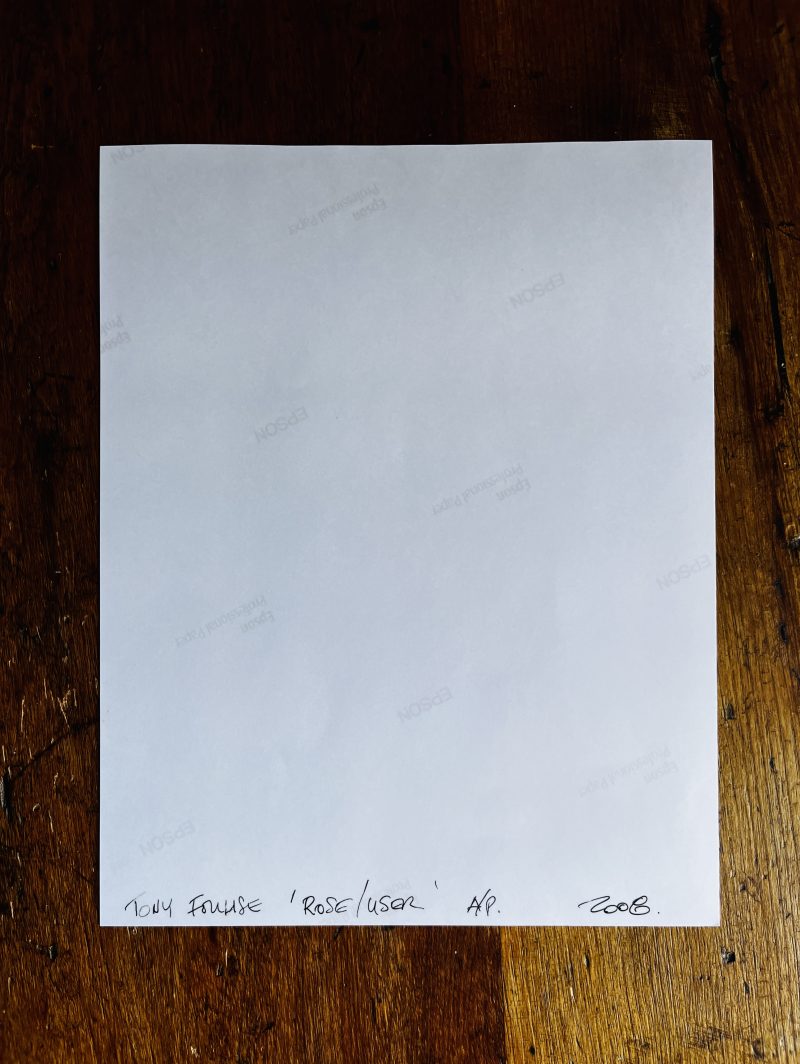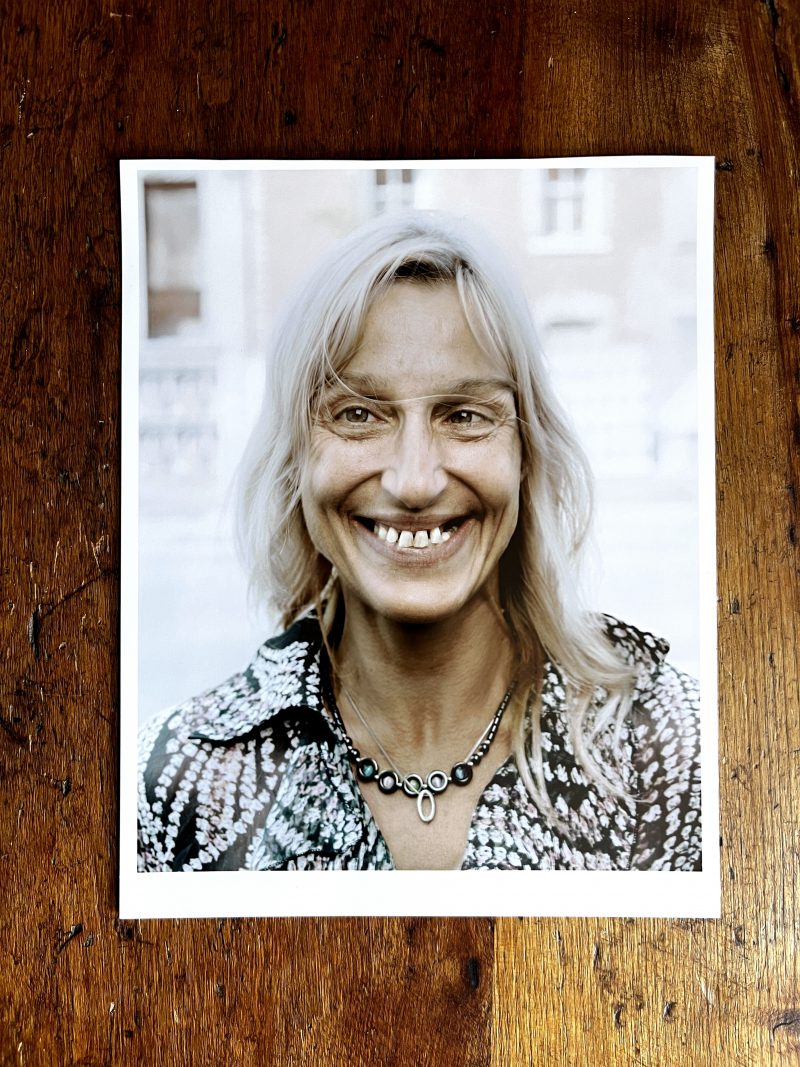Tony Fouhse, ‘Rose / User’ Series, Photograph, 2008
2010 Karsh Award Recipient
Tony Fouhse
Tony Fouhse
Born in 1954, Tony Fouhse is an Ottawa-based photographer, who, for the past 30 years, has balanced his editorial and commercial work with his personal artistic practice. Fouhse, a sophisticated portrait photographer, began by training his camera on the street and never abandoned his roots. His humanist artistic vision has been influenced by his sensibility of the street and its lessons. His work has been featured in numerous publications and exhibited in galleries throughout North America.
Although the people he photographs are frequently outsiders estranged from our demographic centre, his edgy and compelling portraits break down the distance that social differences set up. Sometimes troubling, his images demand active looking from the viewer; obliging us to wrestle with our own unacknowledged assumptions. Fouhse does not judge by pointing his camera ‘up’ or ‘down’ but rather negotiates images of his subjects with an empathy based on mutual respect. He sets the stage by planting his metaphorical tripod right in front of you and then lets you just “be”. A photographer with a strong sense of place and a deeply democratic view of his fellow human beings, Fouhse has been commended for the emotional honesty of his portraiture.

Over the subsequent three-year period, the laureate is also invited to hold an exhibition of his/her work at the Karsh-Masson Gallery, mentor within the local artistic community and participate in the Karsh Continuum exhibition.
In 1932, Yousuf Karsh opened his studio in Ottawa on Sparks Street, where he remained for 40 years. In 1937 Yousuf’s brother Malak immigrated to Canada to apprentice with his brother.
Perspectives on Visual Storytelling
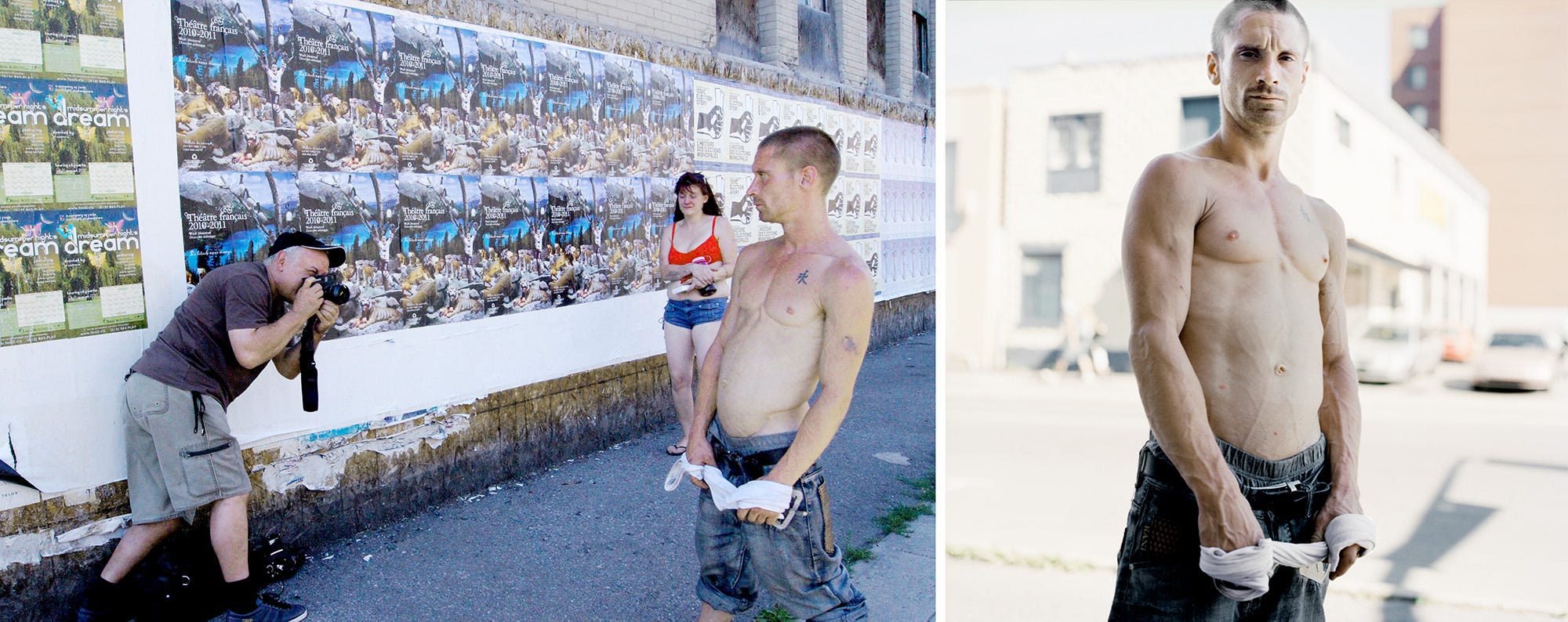
USER
After a brush with death, I stumbled into a project that gave my life new meaning. But meaning comes with a cost.
This is the fourth installation of my photo-life in 5 parts.
Read Part 1: My First Ten Years In Photography, Part 2: Figuring Out How To Turn Photos Into Money, and Part 3: Things Work Out and Things Fall Apart.
So my kidneys failed (see third installment).
I had been traveling to the USA to shoot my American States project. All of a sudden my health and my finances precluded that type of travel. I was stuck in Ottawa, so I thought, “Well, why not photograph here?” (duh). I decided to find strangers on the street, at dusk, and work with them to create little scenarios which I could photograph.
To do this, of course, you need to find people with not only time on their hands, but who also have the inclination to trust a stranger who approaches them on the street and essentially says, “Will you let me recontextualize you with my camera?…”
“… and show the results to a lot of people?”
I went to three or four locations and tried to make it work, but nothing really happened (or I couldn’t make anything happen).
Out of desperation I went a corner where I knew crack addicts hung out. They seemed to always have time on their hands. And they never seemed to be going anywhere.
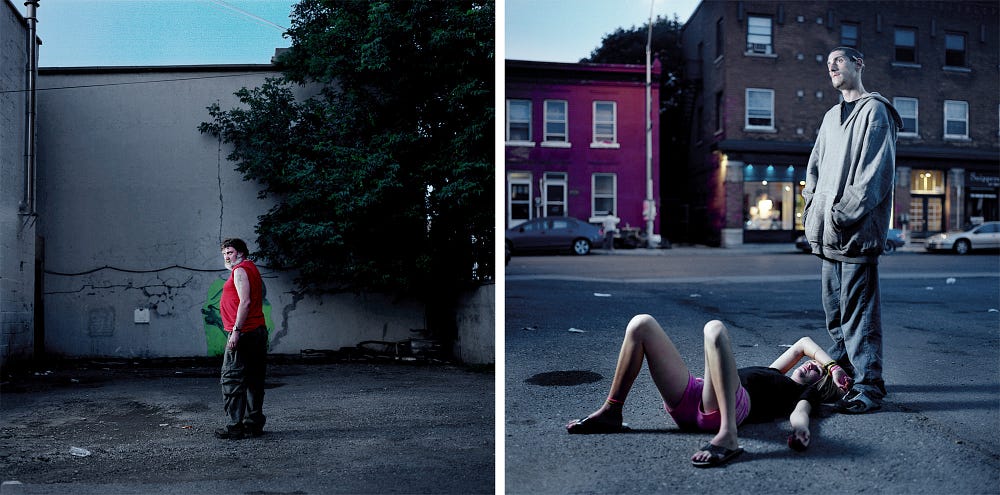
The first time I went, I climbed out of the car, dragging a Hasselblad, a strobe light, a softbox and a stand. I was met with confused and wary looks. After talking to a few of the folks on the corner, explaining who I was and what I wanted, it became apparent that it just wasn’t going to work.
I carried my gear back to my car and was putting it in the trunk when an addict walked up to me and said, “Are you looking for a subject?”
I told him I was and he said I could photograph him. His name was Arnold.
A small group of onlookers gathered, interested in the process, watching me struggle to figure stuff out, seeing that I was working with him to make the photo. After I had finished photographing Arnold, Josh and Tiffany came up to me and offered to pose.
When I got the film back and made the first scans I knew I was on to something. Not only was the look and feel exactly what I was aiming for, the subject matter seemed to matter, too. I made prints, went back to the corner and gave them to Arnold and Josh and Tiffany. A group of addicts gathered, looked at the images and decided I might photograph them, too.

And from there the whole thing just kind of took off. The folks on the corner were amazed that I wasn’t applying the standard “drug addict” cliché to them, that the process and the photos were, up to a point, a collaboration.
I spent a lot of time on the corner that summer. I got to know some of the people very well. There was lots of discussion about what I was doing, about their lives, what had driven them to addiction and the corner. The experiences I was having, the people I met and their stories drilled into my brain. I became obsessed.
I put the work together in a portfolio called USER and showed the images at a gallery right across the corner from where I shot the work. A lot of the big photoblogs featured the work and then it got picked up and used all over the web.
The reason I called this project USER was because the subjects used drugs, I used them, they used me (as a conduit to the outside world) and, as far as I’m concerned, everyone who was consuming the images was using us both.
I still haven’t done a comprehensive edit of this work, still haven’t formed the four-years worth of work into a whole, although there is a rough edit on my website.
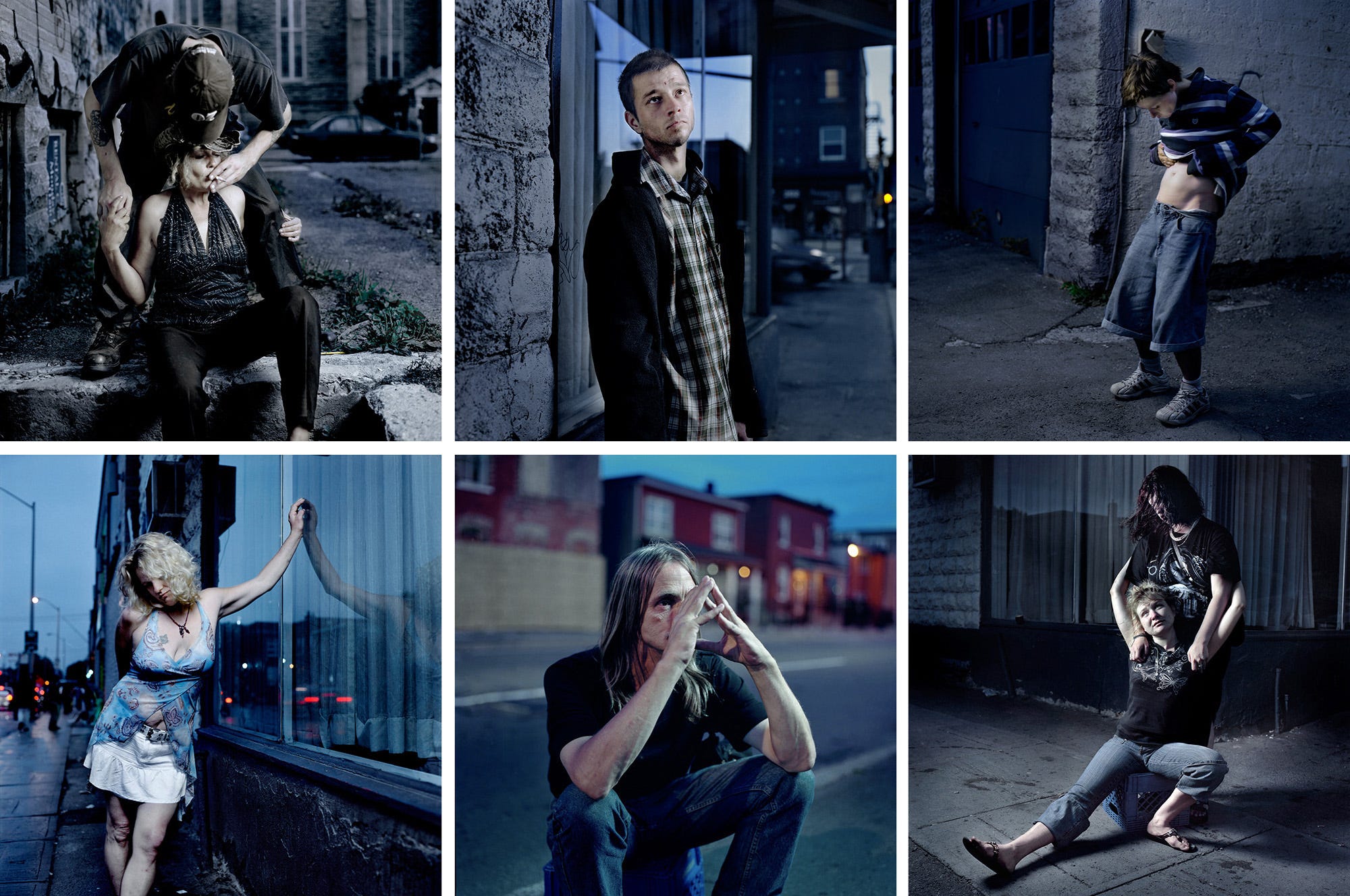
To say there was a shit-storm would be an understatement. I thought I was going down to the corner, meeting people, having conversations and experiences, trying to take interesting photographs. (I’m still naive after all these years.)
Seems that a lot of other people thought I was exploiting the subjects, or glamourizing them … or had no business being there. If you had an axe to grind it would seem that these images were the stone you could use to grind it against. I was getting hate mail from around the world. On the other hand, the photos were also met with a lot of support. I was getting fan mail and support from around the world too. Seemed like a swell balance to me.
The project fulfilled me on so many levels that I decided to carry on shooting there.

After the success of the night images, being the kind of guy I am, I wondered, “What’s the opposite of what I’ve just done?” and came up with the idea of shooting tight shots of the women’s heads.
“Just show their faces”, I thought.
So I went back.
I thought this was going to be easy, after all, what’s so difficult about shooting close-ups of faces? As it turned out, I struggled with this for a while, was so unsatisfied with the first efforts. I tried a few approaches, different backgrounds, different lighting and so on. It wasn’t until I figured out that the drama needed to be grounded in, based upon, the look in the people’s eyes, that, while the images were quiet, there was something running underneath that silence.
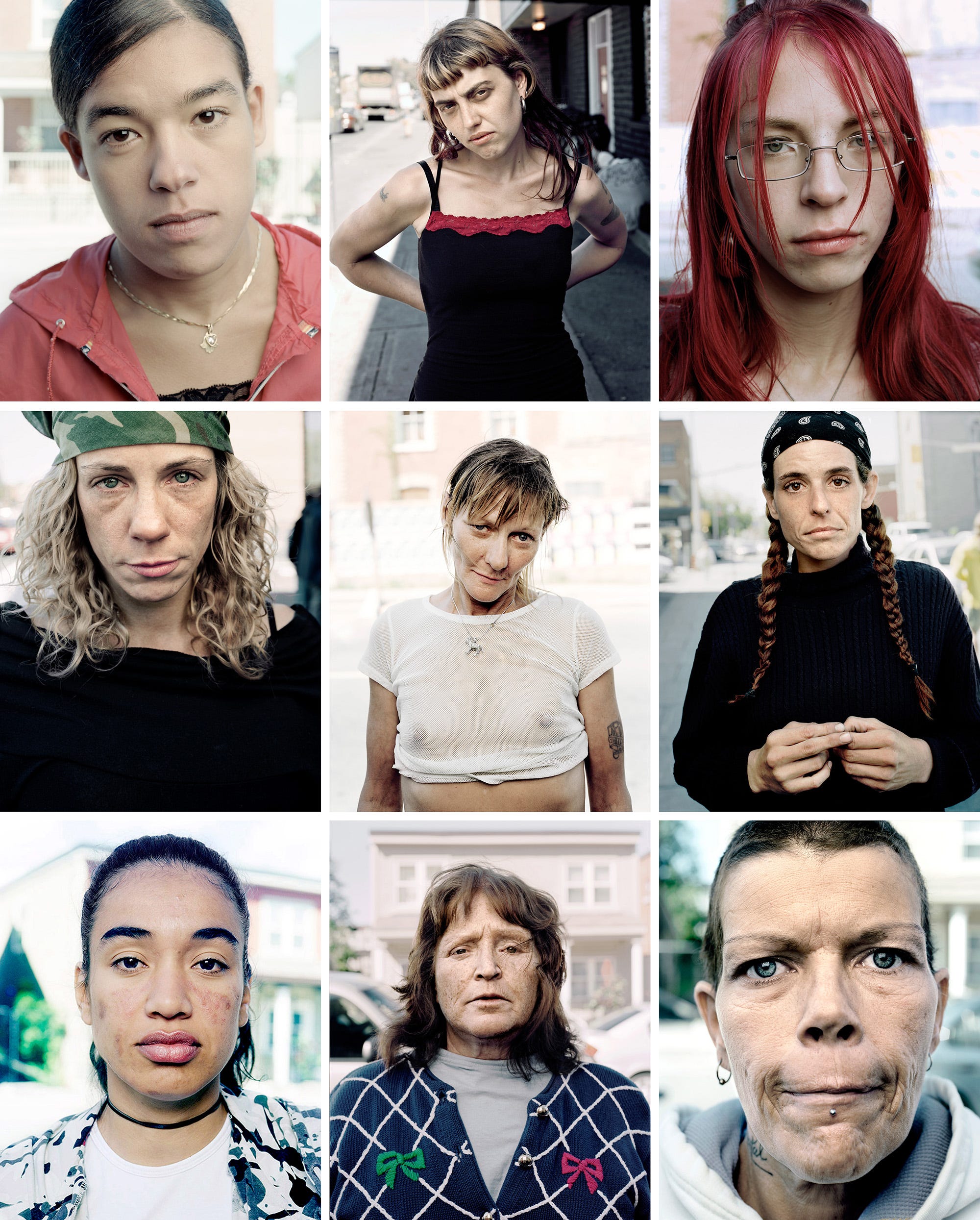
I was falling for that society on the corner, getting in deeper and deeper.
I totally dug how they set their own rules: their beefs would be settled quickly with just as much violence as the situation required, but there was unity and compassion there, too. These people I was photographing, getting to know better and better, seemed like the most honest I’d ever met.

I became kind of addicted to the addicts.
The work I was doing on the corner seemed important, made the commercial work I was doing feel at least inconsequential and, in my darker moments, like just plain propping up the status quo.
These feelings were, I came to realize, fueled by my recent brush with death. I thought it hadn’t changed me, but it had.
The idea of spending my time shooting commercial work seemed like a waste of time: I’d be shooting a job for money in the morning but all I could think about was going to the corner in the afternoon.
I began shooting fewer commercial jobs and spent two more years working on USER. The third year I shot just the men and, as usual, tried to figure out how to show them in a different way than I had photo’d the women and at night.

That done, I had kind of shot myself into a corner — three different bodies of work, all shot with the same subject matter, on the same corner.
I knew I didn’t want the final project to be so distinctly divided, that the final USER project would have to be a mashing together of the Night, the Women and the Men.
In order to give myself options for the final edit, I spent my last year on the corner shooting images that echoed what I had done before, a kind of mashup of darkish, dramatic images, tighter head shots and backlight.

I knew this had to be the last year I worked on the corner. The sights and sounds, the people I was meeting and getting to know, their stories, were consuming me (in more ways than one). I felt a little like Marlow, the narrator of Joseph Conrad’s book Heart of Darkness(or, if you will, Willard, from Apocalypse Now). The horror and the sheer beauty of what I was witnessing, working with and bringing home was slanting my view as to what was important, what was possible (in more ways than one), and what being alive meant.
Despite my resolve to escape the corner, I got sidetracked. The last year, I was shooting there I met Stephanie, a heroin addict. Over the summer, we got to know each other quite well. There was something about her openness, honesty and ability to get in touch with her emotions and show them to me, that amazed me.
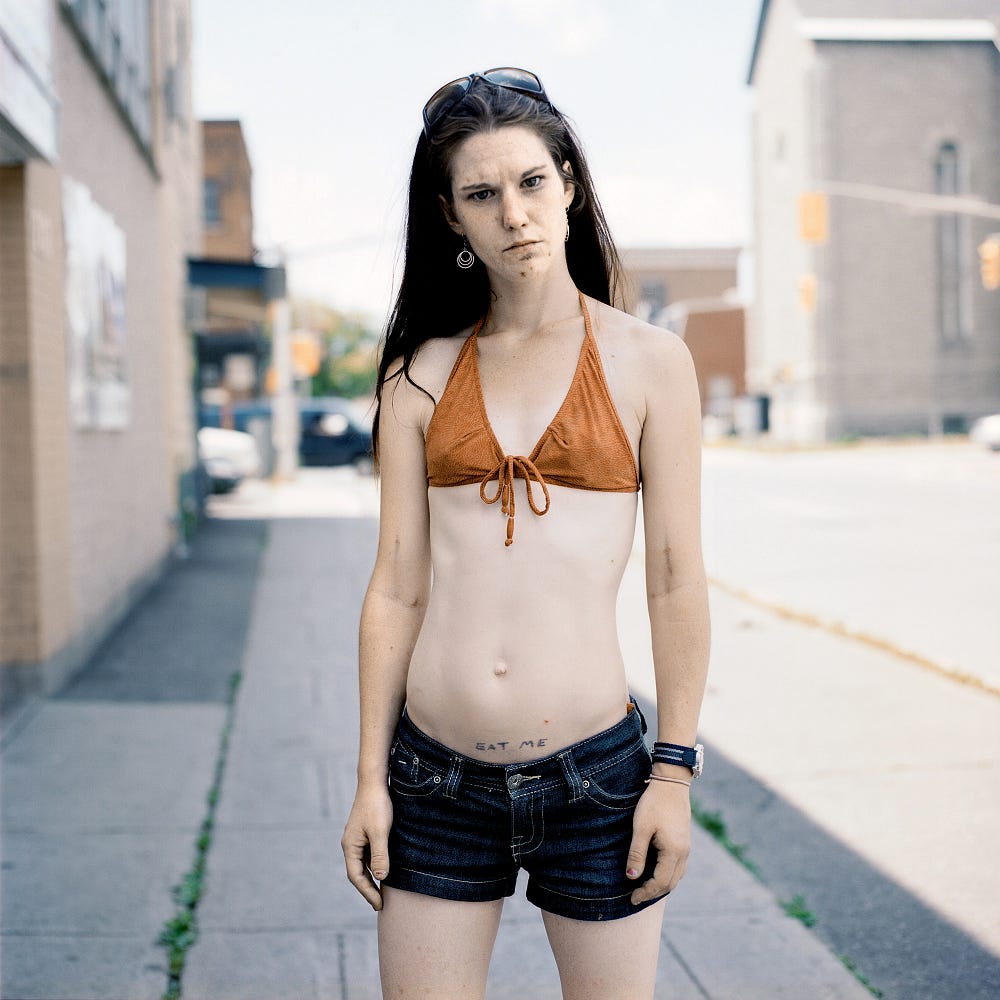
I asked her if there was something I could do to help her.
She asked me to help her get into rehab.
I told her I didn’t know much about it, but I would help her where I could. I asked her if I could photograph the process. She said yes.
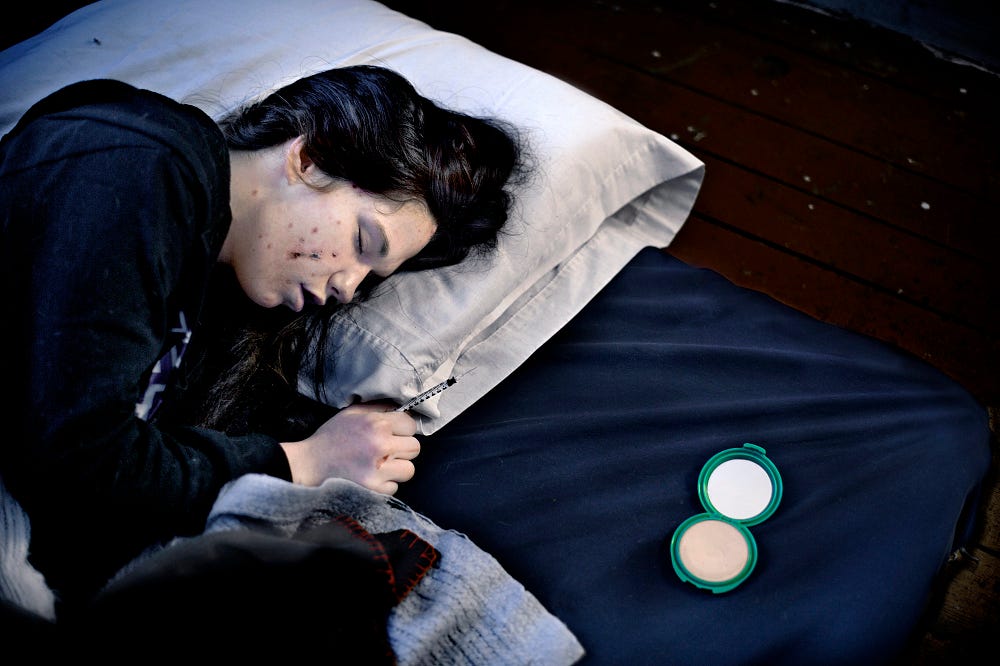
That led me deeper and deeper down the rabbit-hole. I kind of lost my mind…
The fifth and final part of my photo life deals with the journey Steph and I experienced together.
Tony Fouhse is a photographer based in Ottawa, Canada. Follow him on Facebook, Twitter and Instagram. Also worth checking out is his archived years of blog posts.
Fouhse is a publisher of photobooks at Straylight Press, which you can follow on Facebook and Twitter.
Tony is a photographer based in Ottawa, Canada. His work has attracted international attention and been featured in publications such as The New York Times, The British Journal of Photography, American Photography 26, CV Photo, Time magazine and Vie des Arts. His photographs have been exhibited internationally, most recently at the Noorderlicht International Fotofestival in Groningen, The Netherlands (2019); Cortona On The Move photo festival, Italy and, as part of the Beyond Addiction/Reframing Recovery exhibition, in NYC and Rochester, N.Y. (2020).
Images from his personal projects have been acquired by institutional collections including The National Photo Collection of Belgium (on permanent display); the Art Collection of Global Affairs, Canada; the Ottawa Art Gallery Collection; the National Photo Collection, Canada and the Archives of Ontario. Three of his projects have been published as photobooks: Live Through This (2012, ed. 400, sold out), Official Ottawa (2015, ed. 2000, sold out) and After the Fact (2018, ed. 200, sold out).
His awards include a National Magazine Award and the Karsh Award for Photography. He has received arts grants from the Canada Council, the Ontario Arts Council and City of Ottawa.
Tony Fouhse
SOLO EXHIBITIONS
2015 – OFFICIAL OTTAWA, Ottawa Art Gallery Annex
2013 – LIVE THROUGH THIS, Carleton University Art Gallery, Ottawa
2013 – LIVE THROUGH THIS, ViewPoint Gallery, Halifax, Nova Scotia
2012 – ANGELENOS, La Petite Mort Gallery, Ottawa
2011 – USER 2010, La Petite Mort Gallery, Ottawa
2010 – I KNOW YOU ARE BUT WHAT AM I, Karsh Masson Gallery, Ottawa
2010 – AMERICAN STATES, Exposure Gallery, Ottawa USER, Pikto Gallery, Toronto (featured CONTACT exhibition)
2010 – USER, La Petite Mort Gallery, Ottawa
2009 – APRIL + ERIK , Gallery La Petite Mort, Ottawa – USER, IPS Gallery, Montreal
2008 – BESIDE THE PASSAIC, La Petite Mort Gallery, Ottawa
2004 – CALIFORNIA, Galerie La Bouchon, Paris
SELECT GROUP EXHIBITIONS
2016 – Photo Noir, Photo Place Gallery, Vermont
2015 – cARTe blanche, POSTER, REBEL ACTION PLAN. Billboard, Art in Public Places, Ottawa
2015 – THIS IS US NOW, Recent acquisitions, Karsh Masson Gallery, Ottawa
2014 – RECENT ACQUISITIONS, Ottawa Art Gallery
2013 – CRITICAL MASS (touring) Jennifer Schwartz Gallery, Atlanta, Georgia and The Southeast Museum of Photography, Daytona Beach, Florida
2013 – FACE TO FACE, feature exhibition, CONTACT Photography Festival, The Gladstone Hotel, Toronto.
2013 – HEART of the MOMENT: works from the permanent collection, Ottawa Art Gallery
2013 – APPLIED, Exposure Gallery, Ottawa
2013 – STEPHEN HARPER, THE PORTRAIT GALLERY, Arts Court, Ottawa
2012 – THE PRESENT, Oz Studio, Toronto
2012 – CLOSE TO HOME, recent acquisitions, City Hall Art Gallery, Ottawa
2011 – HUMANKIND, Powerhouse Gallery, Brooklyn, N.Y.
2011 – PLACE AND CIRCUMSTANCE, City Hall Art Gallery, Ottawa
2010 – NUDES, Abnorma Gallery, Poznan, Poland
2010 – EVOCATIVE OBJECTS, The Bytown Museum, Ottawa
2009 – SNAP ’09, The Edward Day Gallery, Toronto
2008 – EVIDENCE, City Hall Art Gallery, Ottawa
2008 – HOLGAWORLD, PhotoMedia Center, Erie, Pennsylvania, USA
2004 – THE WORLD, Angel City Gallery, Los Angeles, USA
2004 – ROCK THE VOTE, SAW Gallery, Ottawa
COLLECTIONS
The National Photo Collection, Belgium Art
Collection of Global Affairs, Canada.
City of Ottawa Art Collection
The Ottawa Art Gallery Collection
Archives of Ontario
The National Photo Collection, Canada
Private Collections
PUBLISHED
TIME magazine, LightBox, April 3, 2015 (OFFICIAL OTTAWA feature)
American Photo magazine, Sept., 2013 (LIVE THROUGH THIS profile)
New York Times, June 11, 2013 (Official Ottawa profile, LENS blog)
Ottawa Magazine, September, 2012 (Official Ottawa, 8 page spread)
American Photography 28, 2012
British Journal of Photography, November, 2011 (article on collaborative portraits, LIVE THROUGH THIS)
Esquire Magazine, November, 2011 (15 USER photos)
CV PHOTO, SUMMER, 2011 (10 page spread on USER)
American Photography 27, 2011
American Photography 26, 2010
The New York Times, July 22, 2009 (USER profile)
Fade, The Netherlands (2009)
Vie des Arts, October, 2008 (review of USER at LPM Gallery)
Newsweek Japan, 2008 (6 page spread on USER)
LifeLounge, Australia, 2008 (6 page spread on USER)
Carte Blanche, Magenta Foundation for the Arts, 2006
Many newspaper articles and reviews
GRANTS
OAC Exhibition Grants (2010, 2009)
City of Ottawa Arts Grant (2010, 2012)
Recipient of THE KARSH AWARD for PHOTOGRAPHY, 2010


